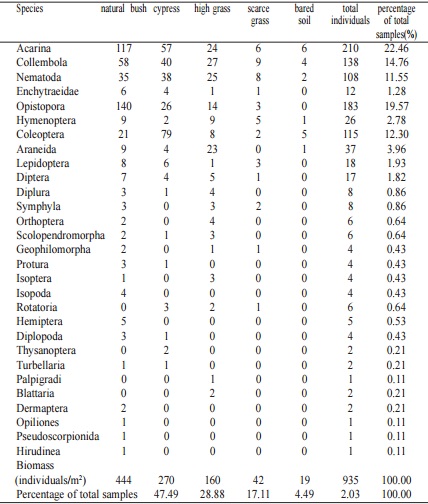The Case Study on Soil Fauna Diversity in Different Ecological System in Shilin NationalPark, Yunnan, China
DOI:
https://doi.org/10.3986/ac.v32i2.347Povzetek
Predhodno sta bili preučevani razporeditev in raznovrstnost talne favne v vrsti degradiranih ekosistemov v narodnem parku Shilin. Ti ekosistemi vključujejo pet tipov rastlinskega pokrova: 1. naravno grmišče, 2. umetno nasajen cipresov gozd, 3. naravni travnik, 4. drugotni travnik, 5. golo rdečo prst. Na vsakem izmed njih je bila talna favna nabrana s kvadrata velikosti 1 krat 1 m. Živali so bile nabrane ročno ali pa izločene s pomočjo segrevanja. V talni favni so prevladovale acarina, collembola, nematoda, coleoptera in opistopora. Toda razmeroma pogoste so bile tudi skupine enchytraeidae, araneida, lepidoptera in diptera. Indeks raznovrstnosti H je manjši od 1,5 in se močno znižuje vzporedno z degradacijo rastlinstva. V kraških prsteh so med najpogostejšimi parholaspidae. Biomasa trhypochthoniidae in ologamasidae je najbolj zgoščena v naravnem grmišču in kaže veliko občutljivost teh skupin na degradacijo rastlinstva. Razmerje biomase acarina v primerjavi s collembola je v razponu 0.7 do 1.5, kar je veliko odstopanje od podatkov za naravne prsti podobnih geografskih širin, znanih iz literature. Majhna biomasa talne favne in manjša raznovrstnost kažeta, da se habitati v preučevanih prsteh slabšajo in se torej slabša tudi zdravje celega ekosistema. Izsledki tudi kažejo na ranljivost talne favne v prsteh z vidika sonaravnega razvoja parka Shilin.
A preliminary study of the distribution and diversity of soil fauna in a sequence of ecosystem degradation in the Shilin National Park, Yunnan, China has been made. The degraded ecologic system includes 5 types of vegetation cover: (1) natural bush; (2) human planted cypress forest; (3)natural grass; (4)secondary grass and (5) bared red earth. A quadrate of 1m×1m in each eco-tessera was sampled for soil fauna collection. The animals were obtained either by picking up or by heat-removing. The soil fauna were dominated by Acarina, Collembola, Nematode, Coleoptera,and Opistopora in these soils. However, Erchytraeidae, Araneida, Lepidoptera and Diptera were also common groups. The diversity index H turned to be less than 1.5, drastically decreasing with the vegetation degradation trend. In the karst soils, Parholaspidae was one of the most populous among the mites. The biomass of Trhypochthoniidae and Ologamasidae was very concentrated in the natural bush ecosystem, showing high sensitivity of mites to vegetation degradation. The biomass ratio of Acarina to Collembola in the studied soils ranged from 0.70 to 1.50, which was in great discrepancy to the results reported of the natural soils at similar latitude. The small soil fauna biomass and less diversity indicated that the studied soil was in a state of deterioration of soil fauna habitats and, in turn, the soil ecosystem health. The results also evidenced that the soil fauna in the karst soil was definitely vulnerable as regarded to the sustainable development of the Shilin Park.
Prenosi

Prenosi
Objavljeno
Kako citirati
Številka
Rubrike
Licenca
Avtorji jamčijo, da je delo njihova avtorska stvaritev, da v njem niso kršene avtorske pravice tretjih oseb ali kake druge pravice. V primeru zahtevkov tretjih oseb se avtorji zavezujejo, da bodo varovali interese založnika ter da bodo povrnili morebitno škodo.
Podrobneje v rubriki: Prispevki




